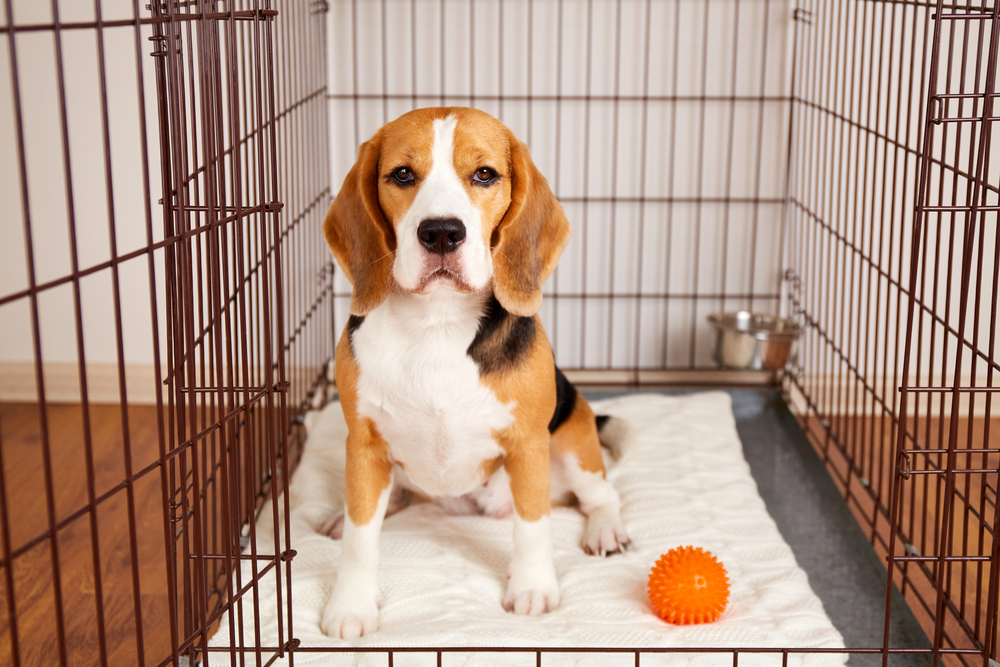When we think of digging dogs, our thoughts often immediately go to a dog digging up the garden to bury a bone or digging in the sand at the beach to get to something tasty that someone dropped. But dogs can engage in digging behaviors in all kinds of environments, including some unexpected places like in their crates.
This odd behavior can be cute or annoying depending on the dog and the owner, but understanding why a dog might be digging in their crate is key to determining if this is an issue that needs attention.
So why do dogs dig in their crate?
Dogs are likely digging in their crate to get more comfortable, an instinctual behavior attributed to digging dens. In some cases, crate digging can also be related to anxiety behaviors, a training issue, or because there is something in or underneath the crate that the dog is trying to get to.
Below we’ll discuss some of the possible reasons as to why your pup might be digging in their crate and whether it’s something to be concerned about or not.
We’ll also look at the differences between crate digging and crate scratching, and how puppies might engage in the behavior a little differently than adult dogs. Finally, we’ll discuss some possible ways to help stop the behavior if it’s not something you want the dog to be doing.
7 Reasons Why Dogs Dig In Their Crate
It’s important to remember that every dog is an individual and your pup may be digging in their crate for a reason not listed here. That being said, many dogs are likely digging in their crate due to one of the following reasons:
Reason 1: It’s A Natural Behavior
Digging is a natural behavior for all dogs, though certain breeds of dog are more likely to engage in digging behaviors than others. Hunting dogs like terriers and beagles are in particular prone to digging, as are thich-coated Northern breeds like the Siberian Husky or Alaskan Malamute.
These breeds have developed reputations for being diggers, and that digging behavior is not just seen out in the flower garden but elsewhere in the dog’s living area including within their crate.
While digging is an instinctual behavior, the need to engage in it while inside a crate is often associated with a secondary reason (likely one of the ones listed below) rather than just the need to dig due to a breed trait.
In many cases, extreme digging in the crate for breeds that are prone to the behavior (which again is a natural behavior) is due to the dog not having a more appropriate outlet for their need to dig.
Reason 2: It’s A Comfort Behavior
Most dog owners will have witnessed their pup digging in their blankets and moving in circles as they attempt to find the “perfect” spot to lay down in. Dogs like to create a comfortable sleeping space just like people do!
While their human owners may be able to fluff pillows and bedding to create comfort, dogs will usually use their paws and a digging action to move their blankets and bedding around.
A crate’s function is to serve as a den, and they are often a smaller living space than if your pup shared your bed or couch with you, that’s why your dog will usually be more inclined to dig around in their bedding or even at their crate mat to try and make it a bit more comfortable and to their liking.
This is especially true if your pup likes to nest into their bedding, which often requires that they thoroughly dig around in the bedding to get underneath and inside it.
For many dogs, this digging behavior becomes almost like a bedtime ritual and the dogs will engage in it as soon as you put them in their crate.
Reason 3: The Dog Is Bored
Digging can also be a sign of boredom in dogs, especially when the behavior occurs mostly when you are not around or outside of a dog’s bedtime routine.
Many owners must leave their dogs crated for a large portion of the working day. If the dog’s physical and mental needs are not met before they are placed in the crate or during their time within the crate, then they may resort to digging within their crate as a way to relieve the boredom and release any pent-up energy.
I’ve found that this type of crate digging behavior is often accompanied by other boredom-related behaviors such as excessive barking, chewing, crying, or howling. Your dog may dig in their crate until their bedding is torn up, or they may even damage the crate floor depending on the material of the crate and how long or often they engage in this behavior.
Reason 4: It’s A Training Issue
Your dog may begin digging in their crate if they’ve determined that it gets them something they want (usually being let out of the crate or attention in some way).
As I often explain to my clients, dogs learn primarily through association, and they are constantly learning from their environment.
The crate digging may have begun due to another reason, but if your dog received something positive out of it (like being let out, a treat, or being allowed onto your bed instead), then they may continue the behavior in the hopes of receiving that positive thing again.
If the crate digging occurs almost as soon as you put your pup in their crate (no matter what time of day) or if the behavior is accompanied by barking, whining, or other vocalizations, then it’s likely a training-related issue.
Similarly, if your dog starts digging, stops and looks at you for a few seconds, then resumes digging (often in the same location of the crate and at an energetic pace), then it’s also likely related to a training issue.
I’ve witnessed dogs who do this will often repeat the behavior and eventually escalate it if their demands are not met.
Similarly, I’ve seen repetitive crate digging in dogs who have low frustration tolerance (usually a result of poor socialization or an owner who does not teach their dog appropriate behaviors in the first place).
It can sometimes be seen in the early to middle stages of the crate training process, too, especially if the owner tries to rush the process or uses punishment-based training practices, which can create a negative association with the crate and result in setbacks.
Reason 5: There Is Something In Or Underneath The Crate
Dogs have an incredible sense of smell, so if even a speck of an odor remains, they may attempt to dig at the spot where the odor is in an attempt to reach it.
This is especially true if the odor was something tasty, or if there’s a piece of food underneath the crate bottom. Sometimes a dog might even dig if there is an insect in their crate!
I see this with my Siberian Husky mix. She’s quite the bug hunter, and if she spots a spider in her crate, she’ll slam her paws down and dig at the crate bottom while trying to catch the spider.
Some dogs also behave in cat-like ways and will use their paws and dig around their crate to play with something in their crate, too (whether that be a toy or a spider!).
Reason 6: The Dog Is Trying To Escape
An escape attempt could be due to fear or anxiety, and it may or may not be related to the crate itself (it could also be related to something in the environment besides the crate).
This type of digging behavior is often very frantic, and dogs who are digging in an attempt to escape will often dig repeatedly in the same spot, to the point where they cause damage to their nails and paws.
This type of behavior is extreme and can be seen in dogs who are kept crated for an excessive period of time without enrichment, who come from puppy mills or pet stores, or who are in an environment that causes a heightened level of fear and anxiety.
If you (or past owners) have accidentally (or intentionally) created a negative association with the crate or the environment the crate is in, you may also see this type of digging behavior from your dog.
This risk of a negative association is one of the primary reasons why it’s never a good idea to use the crate as a form of punishment for a dog.
Your dog may also attempt to escape their crate by digging if they are in a high state of arousal and excitement, like when you return home after a long day at work. In these cases, the digging is likely also related to other underlying training or behavioral issues.
Dogs may also dig in an attempt to escape their crate if they are hungry, thirsty, the ambient temperature is too hot or cold, or need to get away from something near them.
Reason 7: It’s An Anxiety-Related Behavior
Anxious dogs (just like people) have a lot of built-up nervous energy and need a way to express it.
In many cases, I’ve seen dogs express it in harmful ways such as excessive barking, chewing, whining, digging, or other destructive behaviors. They can’t just sit or lay quietly! That energy has to go somewhere, and digging in their crate may be the way a dog chooses to release it.
This anxious behavior is often seen in dogs who are kept crated for an extended period of time, those who suffer from separation anxiety, and those who were rushed through the crate training process (or who did not receive it at all and were simply thrown into the crate).
But what if your dog is exhibiting crate digging and is becoming destructive or harming themselves or even you in any way?
We reached out to Veterinarian Dr. Nita Patel, and her advice is that “the next best step is working with your veterinarian to discuss behavioral modification medications that can aid the pet in controlling anxiety alongside continued training efforts.”
Why Do Dogs Scratch At The Crate Floor?
Scratching at the crate is a bit different than digging within the crate. Scratching behavior is typically very slow and methodical and is often done repeatedly within the same place in the crate and with the same paw.
In most cases, a dog may be scratching at the crate floor because there is something on the crate floor (like leftover residue from a piece of food, or perhaps a smaller insect you can’t see as easily) or there is something underneath the crate floor that your dog smells or hears.
While dogs generally investigate with their noses, ears, eyes, and mouth first and foremost, they may still investigate with their paws if they’re really curious about something on or beneath the crate floor.
Why Do Puppies Dig At The Crate Floor?
While puppies may dig at the crate floor for any of the reasons above, it’s also highly likely that a puppy will begin digging in their crate as part of playtime or just exploring their limbs and figuring out how things work with their bodies.
Puppies love to play, and they will engage in all kinds of different behaviors as they explore the world around them (even if that world is just their crate at the moment).
Digging around in the crate may be a type of play behavior for them, especially if they are performing other play behaviors like small play bows, jumps and twists, or rolls, and appear happy and healthy.
Why Do Puppies Scratch At The Crate Floor?
Like adult dogs, puppies who scratch at the crate floor may have found something that smells good, or there is an odor they are unfamiliar with and want to investigate further. Puppies in the house-training process may also scratch at the crate floor just before they use the bathroom, too.
If you find that this is the case for your pup, getting them on a good crate training schedule and being mindful of taking them outside as soon as you see them scratch at the crate floor can help set them up for success with the potty-training process.
Is It Bad If My Dog Digs In Their Crate?
If your pup is only digging in their crate occasionally or as part of their normal bedtime routine, then it’s likely nothing to worry about.
If the crate digging is due to another issue, such as boredom or a miscommunication with training, then it’s important to ensure that you help your dog find a more appropriate behavior and that all of their needs are met.
Anxiety- or fear-related crate digging is something that should be addressed by a reputable local dog trainer or behavior consultant. If left untreated, the behavior could cause potential injury to the dog, destruction of their crate, and potentially lead to additional behavioral issues.
How Do I Stop My Dog From Digging In Their Crate?
Stopping your dog from digging in their crate depends greatly on the root cause of the digging. If it’s only occasional or is related to their bedtime routine, it’s best to leave them alone.
If it’s causing damage to their feet, claws, or the crate itself, then you can encourage them to do something else instead.
Certified dog trainer Zoie Keast told us that “chewing is an important behavior for dogs, as it helps them to unwind and relax.”
So, do a Down Stay as soon as they get in their crate, and then give them a treat or dental chew to relax them even further.
If the crate digging is due to boredom, ensuring that your pup has received plenty of exercise (both mental and physical) before being placed in their crate is vital to their health and happiness.
For high energy dogs, giving them something to do while in the crate is also a good idea, just make sure the toy or treat is safe for them to use unsupervised.
Keast, suggests that frozen, stuffed kongs and chew bones are a great option for dogs that are bored in their crate as they can keep them engaged for extended periods of time.
Unfortunately, crate digging that is due to fear, anxiety, or an attempt to escape is best left to a professional who can help customize a plan just for your dog and their individual needs.
This type of behavior often has multiple factors besides the crate that need addressing, and owners who attempt to fix it on their own often miss some key information that can help their dog.
Closing Thoughts
It’s important to remember that digging is a natural behavior in dogs, though some breeds may engage in it more often than others.
Digging in the crate is likely due to a dog just trying to get comfortable, but it’s important to look at the individual situation before determining what the true cause is.
In most cases, crate digging is not something to be concerned about, but if the digging is due to a more severe training or behavioral issue, or is medically related, then it’s wise to seek out an evaluation from a professional.




